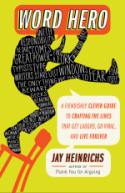Why You Should Know Your Figures
 Know that feeling when you can’t think of a clever retort until it’s too late?
Know that feeling when you can’t think of a clever retort until it’s too late?
The French and Germans, those connoisseurs of humiliation, each had a name for it (l’esprit de l’escalier, stehrwitt). Rhetoric invented figures of speech as a cure for these second thoughts; they arm you with systematic thinking and pre-fab wit so you’re never at a loss again. Figures make you more adept at word play, help you make a cliché seem clever, and can lend rhythm and spice to a conversation.
The Greeks called them "schemes" (schema), a much better word than “figures,” because they serve as persuasive tricks and rules of thumb. While Shakespeare had to memorize more than 200 of them in grammar school, the basic ones aren’t hard to learn. Besides, you already use plenty of figures—analogy (“My love is like a cherry”), oxymoron (“military intelligence”), the rhetorical question (do I have to explain this one?) and hyperbole (the most amazingly great figure of all).
Up until modern times, rhetoricians believed that figures had a psychotropic effect on the brain, imprinting images and emotions that made people more susceptible to persuasion. For all we know, they actually do; modern science hasn’t disproved the theory. At the very least, figures add sophistication. They can attract the opposite sex (at least those who find a clever person sexy). Best of all, they form the coolest vehicle to persuasion, speeding the audience to your argument goals and blowing their hair back.
So let’s pimp your rhetorical ride: Ten Ways to Use Figures.

